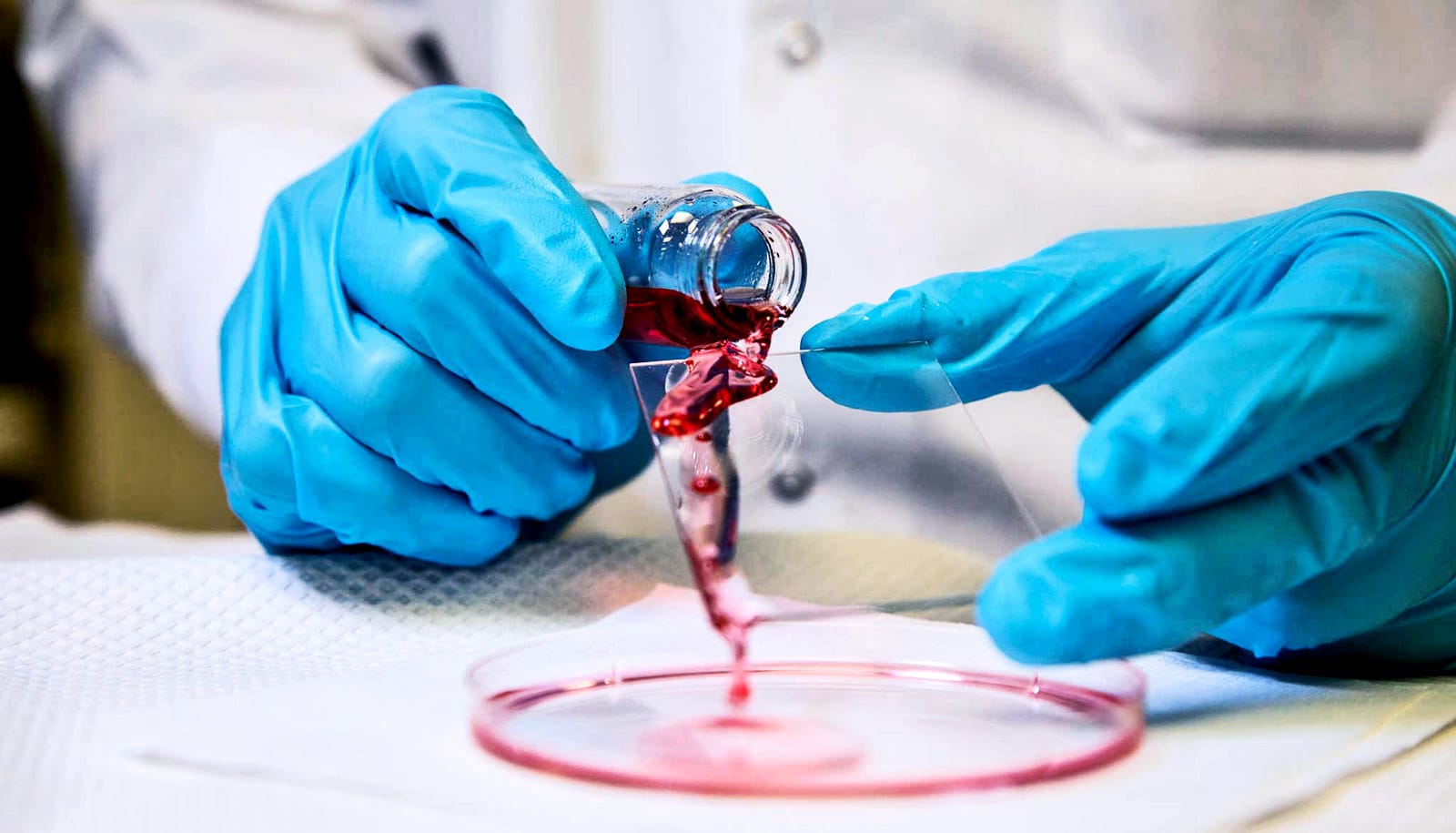 A researcher pours hexadecane oil onto a glass slide with a superomniphobic coating. The petroleum based, highly viscous lubricant slides easily off the slide, opening up applications like self-cleaning windows, ink jet printers, and microfluidic devices. (Credit: Robert Coelius, Michigan Engineering)
A researcher pours hexadecane oil onto a glass slide with a superomniphobic coating. The petroleum based, highly viscous lubricant slides easily off the slide, opening up applications like self-cleaning windows, ink jet printers, and microfluidic devices. (Credit: Robert Coelius, Michigan Engineering)
A smooth, durable, clear coating that swiftly sheds water, oils, alcohol—and even peanut butter—could be a way to keep clean phone screens, countertops, camera lenses, and countless other everyday items.
Called “omniphobic” in materials science parlance, the new coating repels just about every known liquid. It’s the latest in a series of coatings from the lab of Anish Tuteja, associate professor of materials science and engineering at the University of Michigan.
The team’s earlier efforts produced durable coatings that repelled ice and water, and a more fragile omniphobic coating. The new omniphobic coating is the first that’s durable and clear. Easily applied to virtually any surface, it’s detailed in a paper in ACS Applied Materials & Interfaces.
“I have a 2-year-old at home, so for me, this particular project was about more than just the science.”
Tuteja envisions the new coating as a way to prevent surfaces from getting grimy, both in home and industry. It could work on computer displays, tables, floors, walls, and other surfaces.
“I have a 2-year-old at home, so for me, this particular project was about more than just the science,” Tuteja says. “We’re excited about what this could do to make homes and daycares cleaner places, and we’re looking at a variety of possible applications in industry as well.”
The new coating is the latest result of the team’s systematic approach, Tuteja says, which breaks with the traditional materials science “mix-and-see” approach. By mapping out the fundamental properties of a vast library of substances, scientists are able to mathematically predict how any two will behave when they’re combined. This allows them to concoct a nearly endless variety of combinations with very specifically tailored properties.
‘Partial miscibility’
“In the past, researchers might have taken a very durable substance and a very repellent substance and mixed them together,” Tuteja says. “But this doesn’t necessarily yield a durable, repellent coating.”
The new research shows that even more important than durability or repellency is a property called “partial miscibility,” or the ability of two substances to mix together in exactly the right way. Chemicals that play well together make a much more durable product, even if they’re less durable individually.
Tweaking the miscibility of this particular coating posed a special challenge. To make a versatile coating that’s optically clear and smooth enough to repel oils and alcohols, researchers needed to find a repellent ingredient and a binder with exactly the right amount of miscibility, as well as the ability to stick to a wide variety of substrates. They also needed a coating that would stay smooth during processing and drying.
“You can repel water with a rough surface that creates tiny pockets of air between the water and the surface, but those surfaces don’t always repel oils or alcohols because of their lower surface tension,” Tuteja says.
Good mix
“We needed a very smooth surface that interacts as little as possible with a variety of liquids, and we also needed ingredients that mix together very well, because too much phase separation between ingredients will scatter light.”
Ultimately, the team discovered that a mix of fluorinated polyurethane and a specialized fluid-repellent molecule called F-POSS would do the job. Their recipe forms a mixture that can be sprayed, brushed, dipped, or spin-coated onto a wide variety of surfaces, where it binds tightly. While the surface can be scratched by a sharp object, it’s durable in everyday use. And its extremely precise level of phase separation makes it optically clear.
“The repellent and binder mix together well enough to make a clear coating, but there’s a very small amount of phase separation between them,” says Mathew Boban, a materials science and engineering graduate researcher and an author of the paper. “That separation allows the F-POSS to sort of float to the surface and create a nice repellent layer.”
Tuteja believes the coating will be inexpensive by the time it sees the mass market—fluorinated polyurethane is an inexpensive, common ingredient. And while F-POSS is rare and expensive today, manufacturers are in the process of scaling it up to mass production, which should dramatically lower its cost.
Researchers are doing further studies to make sure that the coating is nontoxic for use in places like daycare centers. Tuteja estimates that the coating could go to market within the next two years, and believes childproof coatings are just the beginning.
The coating could also be used in refrigeration, power generation, and oil refining—all industries that depend on the condensation of liquids. It could also let equipment slough off condensed water and chemicals more quickly, increasing efficiency by up to 20 percent. That’s a game changer, as those industries are some of the world’s most high-volume and energy-intensive.
The Air Force Office of Scientific Research, Office of Naval Research, and National Science Foundation funded the work. The University of Michigan and the US Air Force have jointly filed patent applications related to the technology.
